
Daniel Chester French was an American sculptor of the late nineteenth and early twentieth centuries. He is best known for his 1874 sculpture The Minute Man in Concord, Massachusetts, and his 1920 monumental statue of Abraham Lincoln in the Lincoln Memorial in Washington, D.C.

Paul Howard Manship was an American sculptor. He consistently created mythological pieces in a classical style, and was a major force in the Art Deco movement. He is well known for his large public commissions, including the iconic Prometheus in Rockefeller Center and the Celestial Sphere Woodrow Wilson Memorial in Geneva, Switzerland. He is also credited for designing the modern rendition of New York City's official seal.

Fairmount Park is the largest municipal park in Philadelphia and the historic name for a group of parks located throughout the city. Fairmount Park consists of two park sections named East Park and West Park, divided by the Schuylkill River, with the two sections together totalling 2,052 acres (830 ha). Management of Fairmount Park and the entire citywide park system is overseen by Philadelphia Parks & Recreation, a city department created in 2010 from the merger of the Fairmount Park Commission and the Department of Recreation.

Alexander Milne Calder (MILL-nee) was a Scottish American sculptor best known for the architectural sculpture of Philadelphia City Hall. Both his son, Alexander Stirling Calder, and grandson, Sandy Calder, became significant sculptors in the 20th century.

Rittenhouse Square is a neighborhood, including a public park, in Center City Philadelphia, Pennsylvania, United States. Rittenhouse Square often specifically refers to the park, while the neighborhood as a whole is referred to simply as Rittenhouse. The park is one of the five original open-space parks planned by William Penn and his surveyor Thomas Holme during the late 17th century.

Cyrus Edwin Dallin was an American sculptor best known for his depictions of Native Americans. He created more than 260 works, including the Equestrian Statue of Paul Revere in Boston; the Angel Moroni atop Salt Lake Temple in Salt Lake City; and Appeal to the Great Spirit (1908), at the Museum of Fine Arts, Boston. He was also an accomplished painter and an Olympic archer.
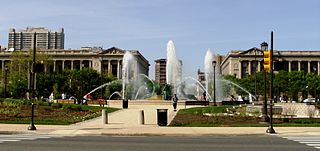
Logan Circle, also known as Logan Square, is an open-space park in Center City Philadelphia's northwest quadrant and one of the five original planned squares laid out on the city grid. The centerpiece of the park is the Logan Circle, a circular area centered on a large water feature, bounded by a traffic circle carrying 19th Street and the Benjamin Franklin Parkway. The circle exists within the original bounds of the square; the names Logan Square and Logan Circle are used interchangeably when referring to the park. Originally "Northwest Square" in William Penn's 1684 plan for the city, the square was renamed in 1825 after Philadelphia statesman James Logan. The park is the focal point of the eponymous neighborhood. Logan Square was added to the National Register of Historic Places in 1981.
Benjamin Franklin Parkway, commonly abbreviated to Ben Franklin Parkway and colloquially called the Parkway, is a boulevard that runs through the cultural heart of Philadelphia. Named for Benjamin Franklin, a Founding Father, the mile-long Parkway cuts diagonally across the grid plan pattern of Center City's northwest quadrant. It starts at Philadelphia City Hall, curves around Logan Circle, and ends before the Philadelphia Museum of Art.

The Swann Memorial Fountain is an art deco fountain sculpture located in the center of Logan Circle in Philadelphia, Pennsylvania, United States.
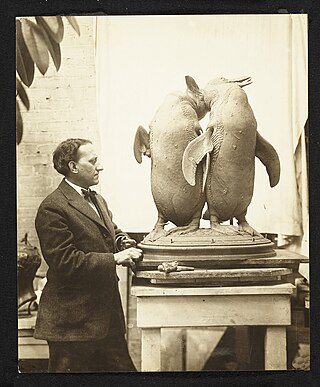
Albert Laessle was an American sculptor and educator. He taught at the Pennsylvania Academy of the Fine Arts for more than twenty years and is best remembered as an animalier. He won the 1918 Widener Gold Medal.
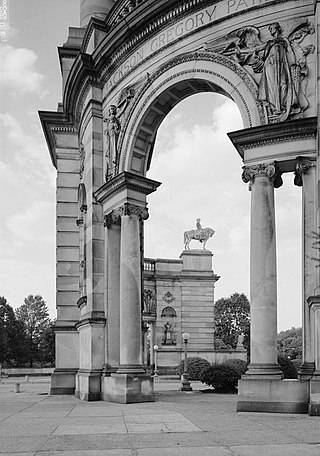
Smith Memorial Arch is an American Civil War monument at South Concourse and Lansdowne Drive in Philadelphia, Pennsylvania. Built on the former grounds of the 1876 Centennial Exposition, it serves as a gateway to West Fairmount Park. The Memorial consists of two colossal columns supported by curving, neo-Baroque arches, and adorned with 13 individual portrait sculptures ; two eagles standing on globes; and architectural reliefs of 8 allegorical figures.

Established in 1872 in Philadelphia, the Association for Public Art (aPA), formerly Fairmount Park Art Association, is the first private, nonprofit public art organization dedicated to integrating public art and urban planning in the United States. The association commissions, preserves, promotes, and interprets public art in Philadelphia, and it has contributed to Philadelphia being maintaining of the nation's largest public art collections.

Eli Kirk Price II was a prominent American Philadelphia lawyer, called "the foremost civic and cultural leader in early twentieth-century Philadelphia". He was the commissioner of Fairmount Park during the planning and development of the Benjamin Franklin Parkway, of which he was one of the principal planners. Later, he was instrumental in obtaining funding for the new Philadelphia Museum of Art building and was President of the museum from 1926 to 1933.

John J. Boyle was an American sculptor active in Philadelphia in the last decades of the 19th century, known for his large-scale figurative bronzes in public settings, and, particularly, his portraiture of Native Americans.
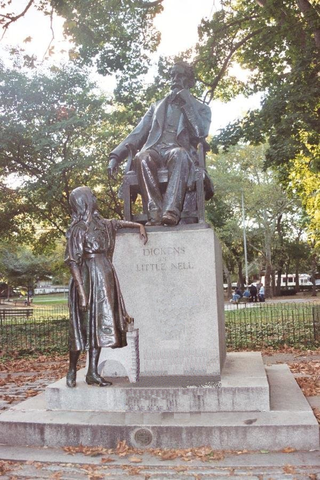
Dickens and Little Nell is a bronze sculpture by Francis Edwin Elwell that stands in Clark Park in the Spruce Hill neighborhood of Philadelphia. The sculpture depicts the 19th-century British author Charles Dickens and Nell Trent, a character from his 1840–41 novel The Old Curiosity Shop. The grouping was one of the most celebrated American sculptural works of the late 19th century.
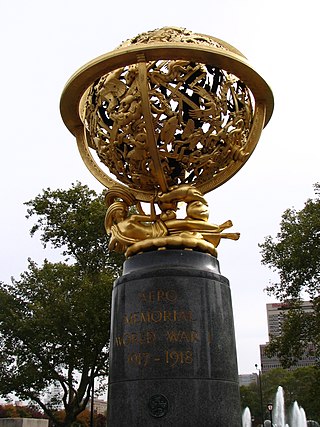
The Aero Memorial is a gilded bronze sculpture by Paul Manship, commissioned by the Association for Public Art. Aero Memorial is located in Philadelphia's Aviator Park, across from The Franklin Institute at 20th Street and the Benjamin Franklin Parkway. The memorial is a tribute to those aviators who died in World War I, and it was initiated by the Aero Club of Pennsylvania in 1917 with the help of the Fairmount Park Art Association. The Aero Club donated modest funds into the Fairmount Park Art Association in 1917 for the creation of the memorial, and after years of fundraising, the Art Association was finally able to contact Paul Manship for the commission 1939. The idea for a celestial sphere was approved in 1944, and the sculpture was completed in 1948. Aero Memorial was dedicated on June 1, 1950. Aero Memorial is one of 51 sculptures included in the Association for Public Art's Museum Without Walls interpretive audio program for Philadelphia's outdoor sculpture.

The James A. Garfield Monument is a monument honoring the 20th President of the United States in Philadelphia, Pennsylvania, United States. Sculptor Augustus Saint-Gaudens and architect Stanford White collaborated on the memorial, which was completed in 1896. It is located in Fairmount Park, along Kelly Drive, near the Girard Avenue Bridge.

Public drinking fountains in Philadelphia, Pennsylvania, United States, have been built and used since the 19th century. Various reform-minded organizations in the city supported public drinking fountains as street furniture for different but overlapping reasons. One was the general promotion of public health, in an era of poor water and typhoid fever. Leaders of the temperance movement such as the Woman's Christian Temperance Union saw free, clean water as a crucial alternative to beer. Emerging animal welfare organizations, notably the Society for the Prevention of Cruelty to Animals, wanted to provide water to the dogs and working horses of the city on humanitarian grounds, which is why Philadelphia's drinking fountains of the era often include curb-level troughs that animals could reach.
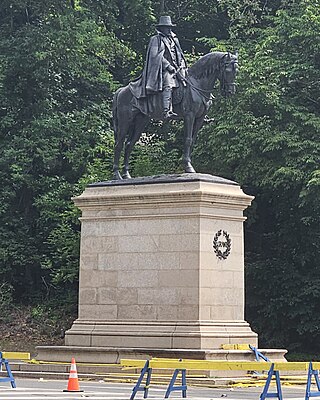
The equestrian statue of Ulysses S. Grant is a public monument in Philadelphia, Pennsylvania, United States. Located in Fairmount Park, the monument honors Ulysses S. Grant, who served as a general in the Union Army during the American Civil War and later as President of the United States. The monument was designed by Daniel Chester French and Edward Clark Potter and consists of an equestrian statue atop a pedestal. The statue was dedicated in 1899.


















